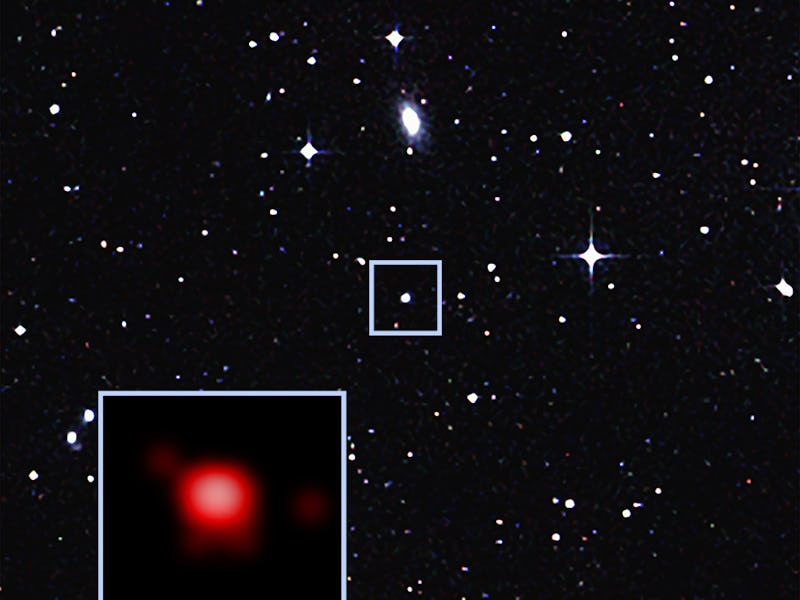This Supermassive Black Hole Eats a Pretty Big Meal Every 9 Hours
We’re talking a million billion billion pounds of cosmic material.

Being a supermassive black hole at the center of a galaxy can really work up your appetite. And one gluttonous black hole was recently discovered to be particularly peckish. Not one to skip a meal, it consumes around a million billion billion pounds of material every nine hours.
While eating on a regular schedule might seem like a normal trait for us Earthlings, it’s pretty odd for a black hole. In fact, as outlined in new research in Nature, no other supermassive black hole has been observed following this kind of strict meal plan.
"We had detected a new kind of cosmic signal."
Giovanni Miniutti, Ph.D., a researcher at the Centro de Astrobiología in Madrid and lead author of the study published on Wednesday, tells Inverse that he had to double check the data at first because of its unusual qualities.
“I almost fell off my chair,” he says. “Never before had we seen something similar from black holes at the center of galaxies…we had detected a new kind of cosmic signal.”
Miniutti’s team first observed the unfamiliar signals coming from the center of a galaxy located 250 million light-years away from Earth. They noticed a series of x-ray bursts that repeated every nine hours, around 20 times brighter than usual — the brightest they had seen from Galaxy GSN 069 in 16 years of observations.
These outbursts indicated that the black hole had been dormant before it tore apart a nearby star and began munching on its stellar debris, the same way you might wake up ‘hangry’ from a nap.
The black hole is estimated to consume three meals a day, each around a million billion billion pounds, or the equivalent of about four moons.
Every time stellar debris falls onto the black hole, it forms a disk of gas that heats up to millions of degrees as it spirals in towards the black hole, emitting light in the form of x-rays. Scientists can estimate the mass of material being consumed based on the total amount of x-rays being emitted.
“These are very important events,” Miniutti says. “They can teach us a lot on how exactly matter gets swallowed into black holes.”
The researchers believe that this particular black hole and its host galaxy, are unique in several ways.
X-ray image of the black hole at the center of GSN 069.
Most notably, the outbursts of x-ray light occurred on a “relatively human timescale,” according to Miniutti, repeating every nine hours.
And though the black hole at the center of GSN 069 is classified as a supermassive black hole, it’s by no means the largest one out there, adds Miniutti. It’s only a few hundred thousand times the mass of the sun, whereas other supermassive black holes are typically ten thousand times larger, he says.
Larger black holes have slower fluctuations in the brightness of light, so as a result, x-ray emissions from other supermassive black holes occur every few years, making their detection much harder.
“When these eruptions are fully understood, and they will — it is a matter of further studies and time — they may provide a framework within which to interpret some of the most puzzling enigmas that we still face in the field,” Miniutti says.
Abstract: In the past two decades, high-amplitude electromagnetic outbursts have been detected from dormant galaxies and often attributed to the tidal disruption of a star by the central black hole. X-ray emission from the Seyfert 2 galaxy GSN 069 (2MASX J01190869-3411305) at a redshift of z = 0.018 was first detected in July 2010 and implies an X-ray brightening by a factor of more than 240 over ROSAT observations performed 16 years earlier. The emission has smoothly decayed over time since 2010, possibly indicating a long-lived tidal disruption event. The X-ray spectrum is ultra-soft and can be described by accretion disk emission with luminosity proportional to the fourth power of the disk temperature during long-term evolution. Here we report observations of quasi-periodic X-ray eruptions from the nucleus of GSN 069 over the course of 54 days, from December 2018 onwards. During these eruptions, the X-ray count rate increases by up to two orders of magnitude with an event duration of just over an hour and a recurrence time of about nine hours. These eruptions are associated with fast spectral transitions between a cold and a warm phase in the accretion flow around a low-mass black hole (of approximately 4 × 105 solar masses) with peak X-ray luminosity of about 5 × 1042 erg per second. The warm phase has kT (where T is the temperature and k is the Boltzmann constant) of about 120 electronvolts, reminiscent of the typical soft-X-ray excess, an almost universal thermal-like feature in the X-ray spectra of luminous active nuclei. If the observed properties are not unique to GSN 069, and assuming standard scaling of timescales with black hole mass and accretion properties, typical active galactic nuclei with higher-mass black holes can be expected to exhibit high-amplitude optical to X-ray variability on timescales as short as months or years.